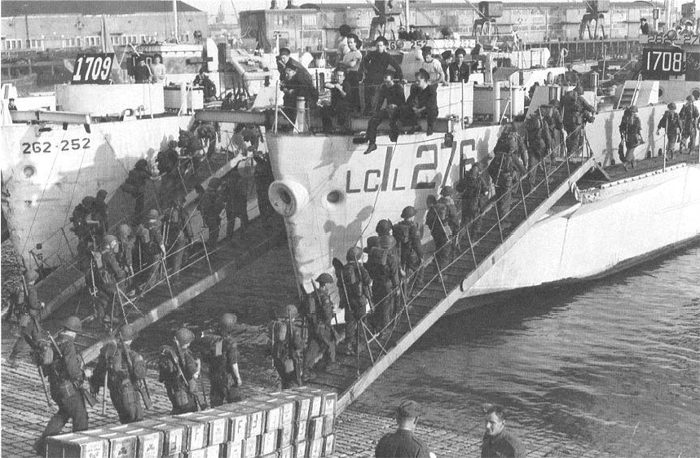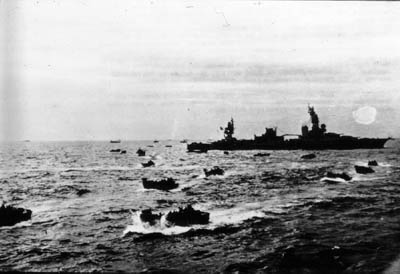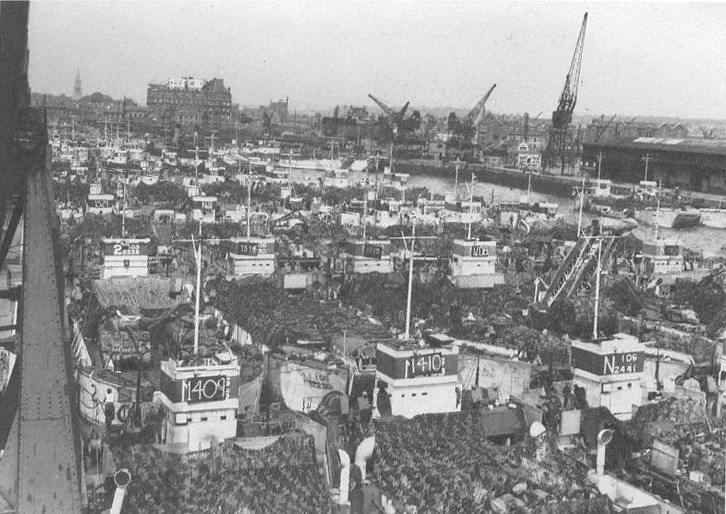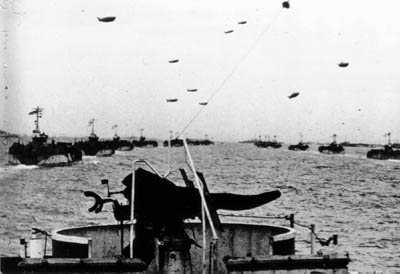

The final plans for Operation 'Overlord', the Allied invasion of France, and its assault phase, Operation 'Neptune' were made in early 1944. The invasion plan called for an amphibious assault by five infantry divisions on a fifty mile stretch of the Cotentin Caen area of the Normandy coast. The five infantry divisions, two British, one Canadian and two American were assigned to beaches code-named, from east to west, Sword, Juno, Gold, Omaha and Utah. Three airborne divisions would land ahead of the main invasion to delay enemy movements and facilitate expansion of the bridgehead. Two American airborne divisions would land behind the western assault and the British airborne on the eastern end. Operation 'Overlord' represented a previously unknown level of cooperation between allied nations, all struggling for the common goal of defeating Nazis Germany.
Under Supreme Allied Commander U.S. General Dwight D. Eisenhower, British General Sir Bernard Montgomery commanded all ground forces in the initial stages of Operation 'Overlord'. The Americans constituted the U.S. 1st Army, commanded by Major General Omar Bradley, the British and Canadians the British Second Army, commanded by General Miles Dempsey. The 3rd Canadian Division was commanded by Major-General R.F.L Keller.

Supreme Allied Commander U.S. General Dwight D. Eisenhower addresses troops.
On D-Day, Canada would land the 3rd Canadian Infantry Division at Juno beach in the centre of Second British Army's sector. The plan called for the Canadians to establish a beachhead, capture the three small seaside towns, and advance ten miles inland. Their objective was to cut the Caen -Bayeux highway, seize the Carpiquet airport west of Caen, and form a link between the British beachheads Sword and Gold. The British were to capture the pivotal city of Caen on the left of the Canadians. The challenge facing the Canadians was to overcome the coastal defences and capture ground positions that could be defended against German counter attacks. The assault was a formidable task for the Canadians as the Germans had turned the coastline into a continuous fortress of guns, pillboxes, wire, mines and beach obstacles.
Over one million Canadians served in the forces during World War II including 50,000 women. The army was the largest service with 700,000 enlistments. The Royal Canadian Air Force had 222,501 enlistments and the Royal Canadian Navy 99,407. By June 1944, 30,000 of these Canadians were poised in Britain for Operation 'Overlord'.

Canadian troops boarding a Landing Craft Infantry (LCI).
The 3rd Canadian Infantry Division supported by the 2nd Canadian Armoured Brigade would land on Juno beach in brigade groups. Two brigades would land in the initial assault followed later by the reserve brigade which would pass through the lead brigades on to the divisional objectives. More than 20,000 men, 200 tanks and hundreds of other vehicles were under the command of Major-General Keller. The original H hour was 7:35 for the 7th Brigade and 7:45 for the 8th Brigade. DD tanks would land 5 minutes before H hour and at H hour itself 2 LCT groups carrying AVRE's, tanks and armoured bulldozers would land and clear beach exits. The infantry would land at H plus 5 when the tanks and engineers had cleared the obstacles and overcome the opposition. Reserve companies would land at H plus 20.
Thousands of Canadian sailors were aboard the landing craft, destroyers, corvettes, frigates, torpedo boats,and minesweepers that would go first. Thousands of Canadian airmen flew in the bomber and fighter squadrons of the RCAF and a parachute battalion would be part of the British Airborne Division. Two more divisions, the 2nd Infantry and 4th Armoured would remain in Britain under Lt. General H.D.G. Crerar who would command the Canadian Army in July. Until then the Canadians would be part of the British Second Army.

Battleship watches over LCAs.
The core formation of the 3rd Division, as in all the Canadian Army was the battalion, the active part of a regiment. Many Canadian regiments were proudly named after their homes such as Winnipeg Rifles and Regina Rifles, while others were named after British regiments. Recruits were drawn from the surrounding area where the regiment was formed and neighbours, friends and brothers served together. The soldiers trained and lived in their regiments for four years and the regiment became the soldier's home overseas.
The enlistment of the Canadian troops into the regiments began in early 1940. They were ordinary people who came from the farming communities, small towns, the factories, and the inner cities from all across Canada. They were the true citizen soldiers of World War II. Some enlisted for patriotism, some for adventure but the majority, because it just seemed to be the right thing to do. They had followed the events in Europe over the last few years and understood the evil that Hitler and Nazi Germany represented. They would fight to end this great evil and bring peace to Europe. On D-Day these citizen soldiers were the spearhead of the Allied invasion of Europe. The Allied D-Day plan relied entirely on each of the regiments to achieve their specific objectives. Within the regiments the Canadian soldiers were determined not to let each other down. They depended on each other - and the free world depended on them.
Cliff Chadderton, Royal Winnipeg Rifles from his documentary Juno Beach to Caen: "The Canadian invasion forces had spent years in Britain training for the task. They had tried very hard not to think of what lay ahead. It was difficult to realize the enormity of what we would be attempting. I was part of that force. However, when we started our assault training on the south of England and in Scotland, we began to realize what loomed before us. Untried troops would dare to set foot in Hitler's Europe. Everyday while in Britain, we heard stories of the heavily fortified French coast which the Germans, in four years with slave labour had turned into a continuous system of guns, pillboxes, mines, barbed wire and on the beaches, underwater pilings, some loaded with explosives waiting to blow up the assault crafts. It was a terrifying picture. The men of the infantry and tank regiments chosen for the invasion simply had to disregard what lay ahead for them across the channel. We just dug in, trained harder, determined to do what some were saying would be impossible."

LCT's with Shermans onboard.
The invasion was set for dawn on June 5, 1944, the hour and day when the tides would be most favourable. Bad weather forced a one day postponement and still the storm raged. On June 5, at 4:15 the Supreme Allied Commander, General Dwight D. Eisenhower listened to the final comments of his advisors, paused, then said: "Okay. We'll go". With that decision a vast array of 5300 ships and landing craft carrying 150,000 men, 1500 tanks, and 50,000 vehicles prepared to move into place for the invasion. A head lay what Winston Churchill called "the most difficult and complicated operation that has ever taken place" - June the 6th, 1944 - D-Day.

RCN-Canadian invasion fleet: View from LCI(L) 306 of the 2nd Canadian (262nd RN) Flotilla showing ships of Force 'J' en route to France on D-Day, 6 June 1944, English Channel.
